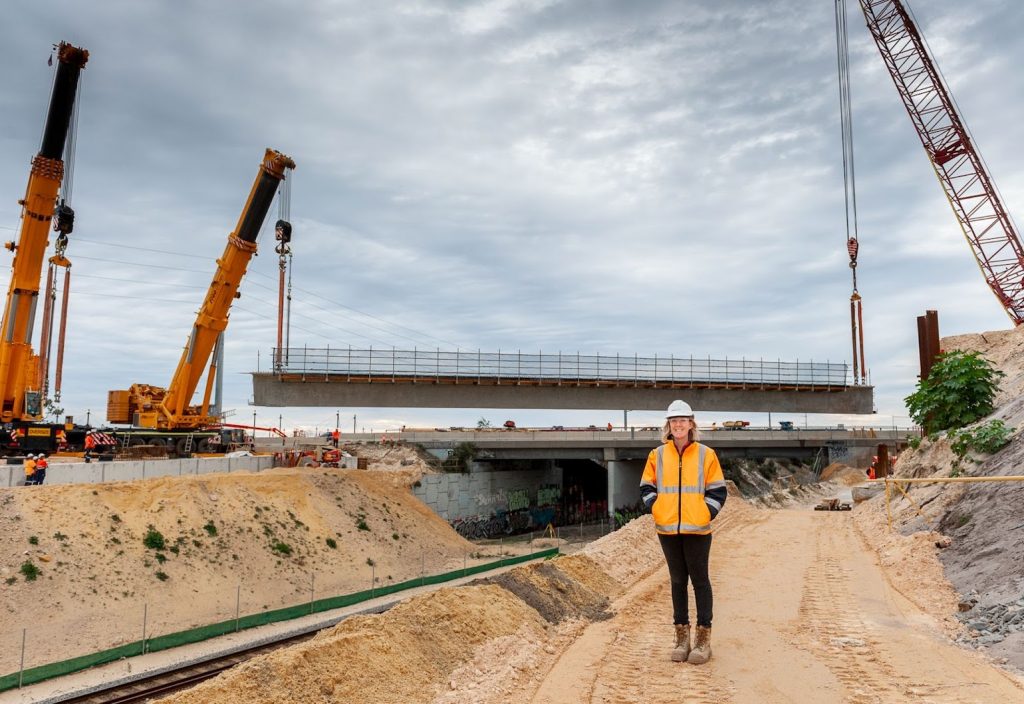Laura Barnes, winner of WA’s 2021 National Association of Women in Construction (NAWIC) Outstanding Achievement in Construction Award, reflects on a career trailblazing through a male-dominated field.
The senior project engineer for METRONET’s Thornlie-Cockburn Link said the award was just one milestone in a busy 2021.
“Working on the beam installation for the Ranford Road Bridge was definitely a highlight,” she told create. “The Ranford beams are the biggest ever fabricated in Australia at 49.7 metres long and 191 tonnes each. The beams were lifted by three cranes — a 400 tonne crawler and 400 and 500 tonne all-terrains — it was like my own personal episode of Megastructures.”
Barnes said that topping off a career highlight with recognition from her peers was humbling.
“NAWIC do an amazing job promoting what women bring to the construction industry, connecting women through networking and mentoring events and highlighting the importance of diversity in the workplace,” she said. “It was lovely to be acknowledged by an organisation I think so highly of.”
Just give it a go
Reflecting on her 7-year career in civil engineering, Barnes said that while she has enjoyed science subjects since her school days, she never saw herself working in construction.
“When I was at uni I never thought I’d end up in bright orange everyday looking at huge cranes but it’s a job and industry I’ve really come to love,” she said.
“I think a lot of people visualise a career in STEM as sitting in a lab or on a computer all day. It’s such a varied field and there’s more than likely a STEM career that will suit your personality and the way you like to work.”
Her advice for other young women looking to enter the field?
“Just give it a go, you never know where it will take you,” she said. “Whether it’s working in a big team or by yourself, in an office or outside, going to university or into a trade, working in Australia or overseas — there are so many opportunities with STEM.
“You’ll also learn transferable skills such as problem solving, teamwork, and communication. Talk to people in the industry about their careers and experiences and where a STEM qualification has taken them.”
Barnes said that it was only during experience with a construction company in her final year of university that she realised construction was a pathway for engineers.
“I had no family members or family friends in construction growing up so I didn’t really know what to expect,” she said.
“I did think of other engineering-based careers. My university course was very theoretical, and design focused so I always figured I’d end up designing structures rather than building them.”
Building blocks for the future

Barnes said that while she’s happy with her career choice, she will continue looking ahead.
“Every day I can walk on site and see the physical changes that are resulting from me and my team’s work. Engineers play a large role in transforming empty paddocks into roads, bridges, railways and tunnels — I really enjoy driving past pieces of Perth I have helped build.”
Of course, there are plenty of day-to-day challenges to be overcome too.
“As a senior engineer you need to balance the interests of multiple different parties, develop construction methodologies that keep people safe, manage quality, cost and programme constraints, stay connected with what’s happening day to day whilst also planning months in advance,” she said.
“It’s a very dynamic, fast paced job and your plans for the day can change with a minute’s notice. Having a supportive site team around you is really important, banter on site definitely helps me manage my stress levels and makes the 10-plus hour days go by pretty quickly.”
As for the future, she hopes to continue working on transformative projects — both for her hometown, and for women in STEM.
“I’d like to continue working on big infrastructure projects in Perth, there’s so much work in the pipeline so the next few years will definitely be busy,” she said.
One such project includes actively promoting flexible working in the construction industry, which sees many women leave in their late 20s to early 30s to start a family and never return.
“The culture is shifting, slowly, and in a post-COVID world the construction industry has realised the show can go on with people working from home,” she said. “This industry is also going through a massive skills shortage, and flexible and part-time working opportunities available that promote work-life balance will attract the talent that companies need.”
